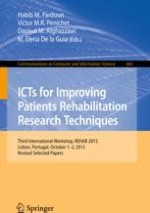2017 | Book
ICTs for Improving Patients Rehabilitation Research Techniques
Third International Workshop, REHAB 2015, Lisbon, Portugal, October 1-2, 2015, Revised Selected Papers
Editors: Habib M. Fardoun, Victor M. R. Penichet, Daniyal M. Alghazzawi, M. Elena De la Guia
Publisher: Springer International Publishing
Book Series : Communications in Computer and Information Science
